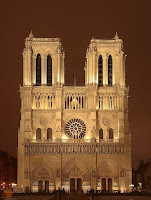Notre Dame Cathedral which is also known as the Notre Dame de Paris, is a Gothic, Roman Catholic cathedral on the eastern half of the Ile de la Cite in the fourth arrondissement of Paris, France. Notre Dame de Paris is widely considered one of the finest examples of French Gothic architecture in the world. It was restored and saved from destruction by Eugene Viollet-le-Dur France famous architect. The name Notre Dame means "Our Lady" in French. Notre Dame de Paris was one of the first Gothic cathedrals, and its construction spanned the Gothic period. Its sculptures and stained glass show the heavy influence of naturalism, unlike that of earlier Romanesque architecture.
 Notre Dame de Paris was among the first buildings in the world to use the flying buttress that is arched exterior supports. After the construction began and the thinner walls grew ever higher, stress fractures began to occur as the walls pushed outward. In response, the cathedral's architects built supports around the outside walls, and later additions continued the pattern. The cathedral suffered ruin during the radical phase of the French Revolution in the 1790s, when much of its religious imagery was damaged or destroyed. During the 19th century, an extensive restoration project was completed, returning the cathedral to its previous state.
Notre Dame de Paris was among the first buildings in the world to use the flying buttress that is arched exterior supports. After the construction began and the thinner walls grew ever higher, stress fractures began to occur as the walls pushed outward. In response, the cathedral's architects built supports around the outside walls, and later additions continued the pattern. The cathedral suffered ruin during the radical phase of the French Revolution in the 1790s, when much of its religious imagery was damaged or destroyed. During the 19th century, an extensive restoration project was completed, returning the cathedral to its previous state.The Construction began in 1163, during the reign of Louis VII. Bishop de Sully went on to devote most of his life and wealth to the cathedrals construction. Construction of the choir is from 1163 until around 1177 and new High Altar was consecrated in 1182. After Bishop Maurice de Sullys death in 1196, his successor, Eudes de Sully oversaw the completion of the transepts and pressed ahead with the nave, which was nearing completion at the time of his own death in 1208. By this stage, the western facade had also been laid out, though it was not completed until around the mid 1240s.
Many organs were installed in the cathedral over time, the earliest ones were inadequate for the building. The first noteworthy organ was finished in the 18th century by the noted builder Francois-Henri Clicquot. Some of Clicquots original pipework in the pedal division continues to sound from the organ today. The organ was almost completely rebuilt and expanded in the 19th century by Aristide Cavaille Coll.

 The position of titular organist at Notre-Dame is considered as one of the most prestigious organist posts in France, along with the post of titular organist of Saint Sulpice in Paris, Cavaille-Colls largest instrument. The organ has 7,800 pipes, with 900 classified as historical. The organ has 109 stops, five 56-key manuals and a 32-key pedalboard. In December 1992, work was completed on the organ that fully computerized the organ under 3 Local Area Networks.
The position of titular organist at Notre-Dame is considered as one of the most prestigious organist posts in France, along with the post of titular organist of Saint Sulpice in Paris, Cavaille-Colls largest instrument. The organ has 7,800 pipes, with 900 classified as historical. The organ has 109 stops, five 56-key manuals and a 32-key pedalboard. In December 1992, work was completed on the organ that fully computerized the organ under 3 Local Area Networks.There are five bells at Notre Dame. The great bourdon bell, Emmanuel, is located in the South Tower, weighs just over 13 tons, and is tolled to mark the hours of the day and for various occasions and services. There are four additional bells on wheels in the North Tower, which are swing chimed. These bells are rung for various services and festivals. The bells were once rung manually, but are currently rung by electric motors. The bells also have external hammers for tune playing from a small clavier.







No comments:
Post a Comment